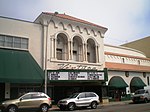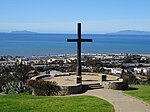Ventura County Courthouse

The Ventura County Courthouse, known since 1974 as Ventura City Hall, is a historic building in Ventura, California. It is located on a hill at the top of California Street, overlooking the city's downtown district with views of the Santa Barbara Channel and Channel Islands. It was the first building in the City of Ventura to be listed on the National Register of Historic Places and has also received historic designations at the state, county and city levels. Built from 1912 to 1913, the Neoclassical courthouse was designed by the noted Los Angeles architect Albert C. Martin Sr. in a Beaux Arts style. The building's facade includes white glazed terra cotta panels and decorations, including 24 whimsical faces of Franciscan friars, fluted Doric columns, a copper-sheathed dome and cupola, as well as Roman-arched windows. The second-floor city council chambers (previously the building's courtroom) include carved mahogany woodwork, stained glass skylights and arched windows overlooking the city and ocean. The courthouse was expanded in the early 1930s with the construction of an annex off the building's west wing. In 1968, the building was declared structurally unsound and county workers relocated. The City of Ventura purchased the building from the county and renovated it at a cost of approximately $3.4 million. The building has served as Ventura City Hall since 1974.
Excerpt from the Wikipedia article Ventura County Courthouse (License: CC BY-SA 3.0, Authors, Images).Ventura County Courthouse
Poli Street, Ventura
Geographical coordinates (GPS) Address Nearby Places Show on map
Geographical coordinates (GPS)
| Latitude | Longitude |
|---|---|
| N 34.2825 ° | E -119.29222222222 ° |
Address
Poli Street
93001 Ventura
California, United States
Open on Google Maps











